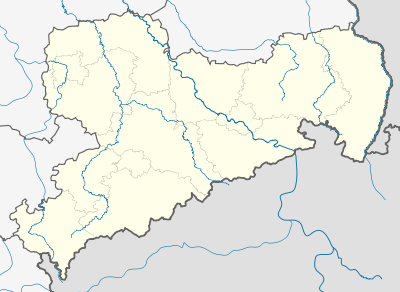Leipzig Wilhelm-Leuschner-Platz railway station
Leipzig Wilhelm-Leuschner-Platz is a new central railway station in the city of Leipzig, Germany. It was built as part of the Leipzig City Tunnel project and opened on 15 December 2013, enabling passengers to travel directly by rail from Leipzig Hauptbahnhof to the city centre.
Leipzig Wilhelm-Leuschner-Platz | |
|---|---|
| Bf | |
 Leipzig Wilhelm-Leuschner-Platz railway station | |
| Location | Leipzig, Saxony Germany |
| Coordinates | 51.335537°N 12.37531°E |
| Line(s) | |
| Platforms | 2 |
| Other information | |
| Station code | 8098 |
| DS100 code | LLWP |
| Category | 5 |
| History | |
| Opened | 15 December 2013 |
| Electrified | at opening |
| Location | |
 Leipzig Wilhelm-Leuschner-Platz Location within Saxony  Leipzig Wilhelm-Leuschner-Platz Location within Germany  Leipzig Wilhelm-Leuschner-Platz Location within Europe | |

Train services
Leipzig Wilhelm-Leuschner-Platz station is served by 7 out of 10 S-Bahn Mitteldeutschland lines. Planners hope that the high frequency service and fast journey times will increase passenger capacity on the city's public transport and thus relieve road traffic in the city.
The following services currently call at the station:[1]
| Preceding station | S-Bahn Mitteldeutschland | Following station | ||
|---|---|---|---|---|
Leipzig Markt toward Leipzig Miltitzer Allee | S 1 | Leipzig Bayerischer Bahnhof toward Leipzig-Stötteritz |
||
Leipzig Markt | S 2 | Leipzig Bayerischer Bahnhof toward Leipzig-Stötteritz |
||
Leipzig Markt toward Halle-Trotha | S 3 | Leipzig Bayerischer Bahnhof toward Wurzen |
||
Leipzig Markt toward Hoyerswerda | S 4 | Leipzig Bayerischer Bahnhof toward Markkleeberg-Gaschwitz |
||
Leipzig Markt toward Halle (Saale) Hbf | S 5 | Leipzig Bayerischer Bahnhof toward Zwickau Hbf |
||
Leipzig Markt toward Halle (Saale) Hbf | S 5X | Leipzig Bayerischer Bahnhof toward Zwickau Hbf |
||
Leipzig Markt toward Leipzig Messe | S 6 | Leipzig Bayerischer Bahnhof toward Geithain |
Tram services
- 2
- 8
- 9
- 10
- 11
- 14
Design
Located 20 m underground, Leipzig Wilhelm-Leuschner-Platz station has a 140 m long island platform. There are two entrances, north and south of the Martin Luther Ring-Road.
References
External links

- City Tunnel website